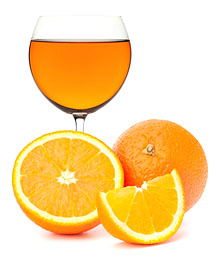 Hi Ed,
Hi Ed,I made my first batch of orange wine from scratch on March 2nd, 2013. My first SG reading was 1.155 for the must. The wine yeast that I had ordered ended up on back order (of course after I started) I went to a local brew shop to get yeast and they only had beer yeast. I tried Cry Havoc. He told me to give it a week. Nothing happened. On the 9th, I added London Ale yeast because it still hadn’t come. The SG was 1.170. I called the supply place and found out the wine yeast wouldn’t be here until the 14th. I was afraid it was spoiling with out the proper yeast, so they told me to add 1/4 teaspoon of potassium metabisulfite (to 5 gal) so I did. On the 14th I strained the fruit out and added Montrachet yeast. It did work! I racked it into a car boy on the 21st. On April 25 the SG was 1.018. On May 5 it was 1.016. On July 13th it was still 1.016. It is very clear and clingy, and it tastes like port. It’s really good! Is it finished, or is the SG too high?
Name: Lori H.
State: CA
State: CA
Hello Lori,
With the readings you gave, that would mean that your wine now has 22% alcohol. This is beyond the capabilities of the Montrachet wine yeast. With that being said, I do not do doubt that your wine is high in alcohol, but probably closer to 16% to 18%. This is the absolute upward limits of the Montrachet yeast, and is seldom reached with a typical fermentation.
Regardless, you would like to have your final gravity reading be down to .998 or lower. A reading of 1.016 is still quite high for an ending reading. Bottling at this point would give you a strong likelihood of a re-fermentation in the wine bottles. This will cause pressure to build in the bottles and a result of either one of two things: corks popping or wine bottles exploding.
Sometimes all it takes is a little patients. If you see the wine hydrometer reading continuing to go down a little every week, just wait it out. If a couple of weeks go by with no change in the hydrometer reading, then you may want to add some yeast nutrient to the wine must. Whatever you do, do not add more wine yeast or sugar. This will only make matters worse.
If you are determined to bottle your wine at the current reading, then you need to get all the wine yeast out of the wine. Then get the wine stabilized. For this I would take the following steps:
- Rack the wine off of any sediment that currently lies at the bottom.
- Add a standard dose of bentonite as directed on our container.
- Cool the wine down to at least 45°F or cooler for one week, but do not freeze.
- Rack the wine off any sediment, again.
- Allow the wine to warm up. (This could take a day or so for 5 gallons)
- As soon as the wine makes it to room temperature add potassium sorbate at the rate of 1/2 teaspoon per gallon.
- Add 1/16 teaspoon per gallon of wine of either sodium metabisulfite or potassium metabisulfte.
- Bottle right away.
The idea with these steps are to get every last bit of wine yeast out of the wine — even the wine that you can not see with the naked eye. Realize that wine yeast is finer than flour. After that, render any wine yeast you missed as harmless with the stabilizers. Here’s another blog post with more on this subject, How To Stop A Wine Fermentation .
Happy Winemaking,
Ed Kraus
———————————————————————————————————
Ed Kraus is a 3rd generation home brewer/winemaker and has been an owner of E. C. Kraus since 1999. He has been helping individuals make better wine and beer for over 25 years.
———————————————————————————————————
Ed Kraus is a 3rd generation home brewer/winemaker and has been an owner of E. C. Kraus since 1999. He has been helping individuals make better wine and beer for over 25 years.

I also made my first batch of watermelon wine from scratch on Jan.26th. 2013. I made 4 times racking till final racking on Sept.8th 2013 an have it bottled at SG 1040. everything was OK for me. From your book (First Steps in Winemaking) page 77 , SG 1040 means percent alcohol by volume is 5.1 but in Lori H. Comment you said, that SG1.016 percent alcohol by volume is 22%. Please, I’m confused here.
Sometimes all it takes is a little patients…………patience !
William/Ghana, a single Specific Gravity reading can not tell you how much alcohol you have in the wine. It takes two readings: one taken before the fermentation and one take after the fermentation. By comparing the two readings you can determine the wine’s alcohol level. You can read more about this at the following link:
"How To Determine Your Wine’s Alcohol Level"
http://blog.eckraus.com/wine-making-tricks-and-tips/how-to-determine-your-wines-alcohol-level